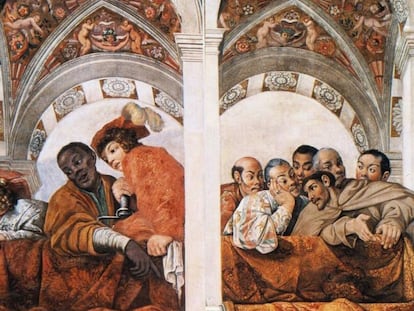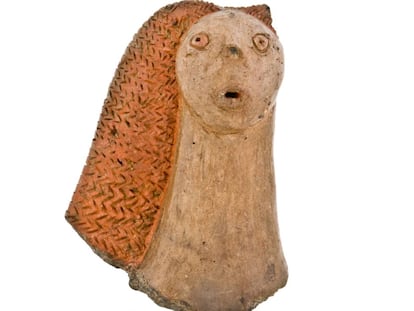Were the Vikings fashion trendsetters of the Medieval age?
Until recently it was assumed the seafaring raiders of lore wore clothes suited to their reputation for barbarity, but recent studies suggest those savage breasts would have sported brooches and that the Norsemen were fans of dressing to kill
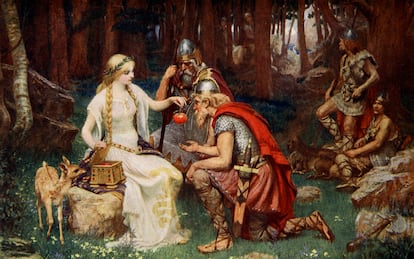
The Saxon chronicles (and those of France and Galicia) describe the Vikings as genuine brutes. Rude, crude and wild, tall with long hair and abundant beards, fierce eyes set in faces covered with scars, their arms covered in tattoos, blood and ritual incisions in their teeth. Witnessing them in action must have been a terrifying spectacle.
There is no doubt that they inspired dread in their victims. For the monks and peasants of western Europe in the 8th and 9th centuries, Viking raids were like solar eclipses, catastrophes of biblical proportion as the demonic horde descended. The invaders were a civilization with a rich oral culture but one that did not write its own books, so the accounts that have been passed down are recorded from the victims’ point of view. Nonetheless, recent publications such as Children of Ash and Elm; a History of the Vikings by Neil Price, suggest that these brutes were in reality considerably more refined than originally thought. Not the epitome of barbarism and dishevelment but instead a people who took pride in their appearance and had an acute affinity for esthetics, hygiene and fashionable clothes.
Price dedicates a demythologizing chapter to the sartorial elegance of the Germanic tribes forged in the valleys and fjords of Scandinavia, in which he argues that theirs was a very visual culture, one obsessed with appearances and in which at least some of the political and financial elite attired themselves in sumptuous imported garments (silk was valued as a treasure), of exquisite design and rich colors. It is true that a Viking’s work clothes generally consisted of a basic tunic, a metal helmet (despite popular belief without horns), a sheepskin vest and a coat of mail. But the Scandinavians of the era knew how to scrub themselves up when they had something to celebrate or someone to impress.
Dressed to kill
The Vikings also bathed frequently, if not on a daily basis, and held accessories in high regard, frequently sporting brooches, rings and combs in their hair, and their tattoos, far from being crudely applied ink stains, were intricate artworks carrying ritual significance that today, unfortunately, we know little about. This side of Viking culture and their material customs had passed unnoticed for centuries, lost amid so many blood-soaked tales of pillage and ceremonial barbarity, but recent archeological discoveries suggest that it was in fact one of the most elegant societies in northern Europe during the transition period between the Iron and Middle Ages.

Jacinto Antón, a journalist who has held a lifelong fascination for the Vikings, says some nuance is necessary. “If we are discussing Viking elegance, we have to refer only to the top of the social pyramid in Scandinavian societies. Everyone else was subject to the material poverty of the era and wore serge, wool items and cheap dresses, as did French peasants, Goths and Saxons.” It is true, however, that the Vikings “did not fit the archetypal image of unkempt barbarians.” Theirs was a culture that valued hygiene and apparel. “Even Muslim ambassadors in Scandinavian courts or the Arab peoples that traded with them on the banks of the Volga or in the Caspian Sea couldn’t help but notice that they washed and paid a great deal of attention to personal hygiene and sharp dressing.”
It is also well documented that in numerous excavations of warrior tombs, according to Price, an abundance of combs, jewelry, masks and sophisticated garments have been discovered. In an interview with Antón, Price explained the reasons for these findings. “The Scandinavians had a certain fear of the void that they compensated for by collecting objects, drawing and decorating, which is why their material culture was so rich. They were not illiterate but they had no knowledge of books. Even their form of writing, in runes, was based more on a desire for visual spectacle than that of a creating a story.”
Furthermore, the Vikings traveled extensively, “which allowed them to evolve into masters of non-verbal communication.” Price also says that in reality, “their terrifying appearance in battle, of covering their bodies in tattoos, filing their teeth, appearing out of nowhere reeking and drenched head to toe in blood, all formed part of a strategy of intimidation and warlike propaganda designed to sow terror among their enemies.” Their tattoos, in particular, “were ritual ornaments for combat not very different from those used by the Picts or the Celts and that are still used today by organized crime syndicates like the Yakuza in Japan.”
Androgynous pioneers
Price places a lot of importance on recent discoveries that have contributed to altering our mindset about the Vikings. One such example is a silver-plated figurine uncovered in 2014 in the Danish town of Haarby, near Roskilde, depicting what is thought to be a warrior from 800 AD dressed in an ambiguous way (androgynous?), with a pleated petticoat reaching to his ankles and an extravagant V-necked shirt, an ornate cape and a long vest rounded off with a coquettish skirt.
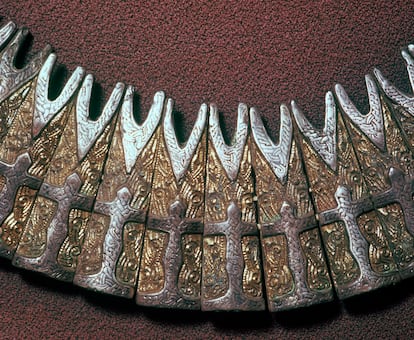
Apparently get-ups like this, which today would seem to us to speak of overt feminism, were worn above all by men of the warrior aristocracy, who were also fond of sporting shawls, brooches, linen tunics, tiaras and delicate leather boots. These men of war were generally dressed up to the nines before burial or cremation with deliberate ostentation to display their material wealth, which demonstrates to what extent these so-called barbarians valued their personal appearances. According to Price, at least two-thirds of a chieftain’s fortune would be lavished on his funeral, which would include a multitudinous feast with an open bar. At the most, the family would inherit the remaining third. The business of death is far from being a modern invention.
Dedicated followers of fashion
Price also notes that the ancient Norsemen were not familiar with pockets but instead had a wide range of brocades, necklaces, jewels, buttons made from bone or metal, silk or wool hats and colorful children’s clothing including nightgowns and tunics. They even designed such extravagant garments as a pair of leather-covered baggy trousers, a last hurrah on the 9th century Scandinavian catwalk popularized, it seems, by one of the Vikings’ most celebrated heroes, Ragnar Lothbrok, whose name means literally “shaggy breeches.” As much as for his military feats, Lothbrok’s contemporaries were awed by the fashions he made popular in a curious example of how seriously (or perhaps how mockingly) good taste and elegance was regarded among these seafaring men of war.
Antón highlights of Price’s book “the special attention the author dedicates to the most overlooked part of the Viking epoch, the travels of the Rus, those Swedish traders and warriors who opened the routes to eastern Europe by traversing the great rivers of Ukraine, Russia and Belarus.” The journalist notes that these achievements of discovery in the east and west were “the work of a minority, those who called themselves Vikings (which is to say, pirates or raiders). The majority of Scandinavians of the time were simple farmers laboring under a subsistence economy in a hostile atmosphere not much different than in the rest of the known world at that time.”
Antón concurs with Price that it makes little sense to try and sway the pendulum of historical assessment of the Vikings to view them as entrepreneurial and cosmopolitan traders who concerned themselves with good food and snappy dressing. “There are recently published books that point in this direction, but in my opinion they are mistaken. Sure, we now know that they were not blood-thirsty savages, or at least not only that, but nor should we seek to turn them into a paradigm of civilization or good manners.”
The Vikings perhaps do not deserve the bad press that their staunchest enemies sought to give them, but their reputation cannot be laundered or vindicated from a naïve and ingenuous viewpoint. However clean their tunics may have been, they performed human sacrifices, launched unprovoked attacks on countries that had previously been trading partners and engaged in the slave trade. Scandinavian women of the age could divorce, inherit land and titles and fight in combat, but they were also subjected to the rigors of a patriarchal and zealously misogynistic society in which selective infanticide targeted girls and sexual violence was commonplace. “They were neither saints nor devils,” says Antón. “They were simply a very distinctive people with values and a way of viewing life that we don’t understand today.”
From the Baltic to Istanbul
The Viking odyssey, as Price narrates, is the story of a people who took advantage of the collapse of the Roman empire and the subsequent era of large-scale migrations to open themselves up to the wider world at a time when the northern third of Eurasia was being globalized through forced marches. They were as much pirates as explorers and traders and they constructed a vast network of contacts that took them to such remote locations as Baghdad, Constantinople and the steppes of Central Asia as well as the places on the map they are more well-known for sacking and populating such as Britain and Normandy, Galicia, Cantabria and the Balearics in Spain, Italy and northern Morocco. Their journeys across the northern Atlantic took them across the Arctic circle several times. They colonized the Hebrides and the Orkneys, they invaded Ireland, England and Scotland and gained a foothold in such inhospitable places as Iceland and Greenland and ranged as far as Newfoundland and Labrador in modern-day Canada.
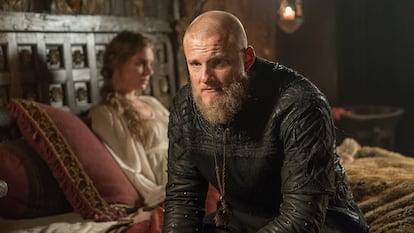
The History Channel’s popular series Vikings, created by Michael Hirst, follows this unprecedented series of adventures that took place between the 8th and 11th centuries and uses the Icelandic sagas (which were written many years later in the Middle Ages) and other historical and literary sources as well as the latest archeological discoveries to depict the era. Other works of fiction, such as The Last Kingdom (Netflix), have settled for a far more conventional vision. “I like Hirst’s series,” says Antón. “And I understand that Price also thinks highly of it. He considers it strong and well-documented.”
Antón thinks it logical that Hirst, who he has also interviewed recently, took certain liberties in creating a work of dramatic coherence. “Perhaps what I found least convincing was how one of the most important personalities of the Nordic sagas, Ivar the Boneless, was portrayed. His name was probably the result of a slight limp or sexual impotence. In the series, he suffers from a serious disability that forces him to crawl on the floor and even so he becomes one of the greatest military leaders of the age, something that is highly implausible in a society that valued physical strength and fitness above all else.”
On the other hand, Hirst’s series does show how the Vikings dressed for the occasion when holding great feasts, those lavish banquets soaked in beer and grain alcohol that were held to celebrate successful expeditions across the high seas. Then as now, style was no obstacle to efficiency.
English version by Rob Train.
Tu suscripción se está usando en otro dispositivo
¿Quieres añadir otro usuario a tu suscripción?
Si continúas leyendo en este dispositivo, no se podrá leer en el otro.
FlechaTu suscripción se está usando en otro dispositivo y solo puedes acceder a EL PAÍS desde un dispositivo a la vez.
Si quieres compartir tu cuenta, cambia tu suscripción a la modalidad Premium, así podrás añadir otro usuario. Cada uno accederá con su propia cuenta de email, lo que os permitirá personalizar vuestra experiencia en EL PAÍS.
¿Tienes una suscripción de empresa? Accede aquí para contratar más cuentas.
En el caso de no saber quién está usando tu cuenta, te recomendamos cambiar tu contraseña aquí.
Si decides continuar compartiendo tu cuenta, este mensaje se mostrará en tu dispositivo y en el de la otra persona que está usando tu cuenta de forma indefinida, afectando a tu experiencia de lectura. Puedes consultar aquí los términos y condiciones de la suscripción digital.
